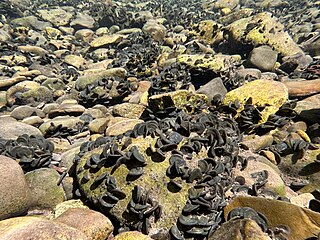
The Culicomorpha are an infraorder of Nematocera, including mosquitoes, black flies, and several extant and extinct families of insects. They originated 176 million years ago, in the Triassic period. There are phylogenetic patterns that are used to interpret bionomic features such as differences in the nature of blood-feeding by adult females, daytime or nighttime feeding by adult females, and occurrence of immature stages in aquatic habitats.

A midge is any small fly, including species in several families of non-mosquito nematoceran Diptera. Midges are found on practically every land area outside permanently arid deserts and the frigid zones. Some midges, such as many Phlebotominae and Simuliidae, are vectors of various diseases. Many others play useful roles as prey for insectivores, such as various frogs and swallows. Others are important as detritivores, and form part of various nutrient cycles. The habits of midges vary greatly from species to species, though within any particular family, midges commonly have similar ecological roles.

The Chironomidae comprise a family of nematoceran flies with a global distribution. They are closely related to the Ceratopogonidae, Simuliidae, and Thaumaleidae. Many species superficially resemble mosquitoes, but they lack the wing scales and elongated mouthparts of the Culicidae.

Chaoboridae, commonly known as phantom midges or glassworms, is a family of fairly common midges with a cosmopolitan distribution. They are closely related to the Corethrellidae and Chironomidae; the adults are differentiated through peculiarities in wing venation.

The Chironomoidea are a superfamily within the order Diptera, suborder Nematocera, infraorder Culicomorpha. This superfamily contains the families Chironomidae, Ceratopogonidae, Simuliidae, and Thaumaleidae.

Orthocladiinae is a subfamily of midges in the non-biting midge family (Chironomidae). For lack of a better common name, they are simply referred to as orthoclads.

Cricotopus is a genus of non-biting midges in the subfamily Orthocladiinae of the bloodworm family Chironomidae.
Halocladius is a genus of halophilic, non-biting midges in the subfamily Orthocladiinae of the bloodworm family (Chironomidae). They inhabit seashores and saline inland waters of the Northern Hemisphere. Wing length is 1.5–3.5 mm (0.06–0.14 in). Two subgenera have been described: Halocladius and Psammocladius.

Chironomus is a genus of nonbiting midges in the subfamily Chironominae of the bloodworm family, Chironomidae, containing several cryptic species that can only be distinguished by experts based on the characteristics of their giant chromosomes.

Chironominae is a subfamily of midges in the non-biting midge family (Chironomidae).

Tanypodinae is a subfamily of midges in the non-biting midge family (Chironomidae). The larvae are generally carnivorous and their mouthparts are adapted for predation on small invertebrates although 1st and 2nd instar larvae also feed on algae.

Diamesinae is a subfamily of midges in the non-biting midge family (Chironomidae).
Clunio marinus is a non-biting midge of the bloodworm family (Chironomidae). It is found in the intertidal zone of the European Atlantic Coast from Spain to Iceland. The species is a long-standing model system in chronobiology, particularly for circalunar clocks and the evolution of biological clocks. Its genome has been sequenced.
Smittium is a genus of fungi in the order Harpellales. It is the largest genus in the order. As of 2013, there were 81 described species. Many of these have been formally described only recently; in 1998 there were just 46. Several have been transferred to Smittium from other genera, such as Orphella, Rubetella, Genistella, and Typhella. In general, the genus has a cosmopolitan distribution, but some species are limited to small regions.

Pontomyia is a genus of flightless marine midges belonging to the subfamily Chironominae in the Chironomidae family. Insects in marine environments are extremely rare while flightlessness, extreme sexual dimorphism, and an extremely short adult life span contribute to making these midges unusual among insects. They are known from the shores of islands in the Indian, Atlantic and Pacific Oceans.

Cricotopus bicinctus is a species of fly in the family Chironomidae. It is found in the Palearctic.

Cricotopus sylvestris formerly Cricotopus silvestris, is a species of midge in the family Chironomidae. It is found in Asia, Europe, The United Kingdom, and North America.
Chironomus annularius is a species of non-biting midge in the family Chironomidae. It is usually found in regions with bodies of fresh water but can be found in almost every environment. It tends to form "hotspots" around specific areas. The species is distinguished by the size of its chromosomes and the lack of a proboscis.

Tokunagayusurika akamusi is a midge fly species of the family Chironomidae, commonly called "nonbiting midges" or "lake flies."

Nostoc parmelioides is a species of cyanobacterium in the family Nostocaceae. It is notable for its symbiosis with a midge larva, Cricotopus nostocicola.












